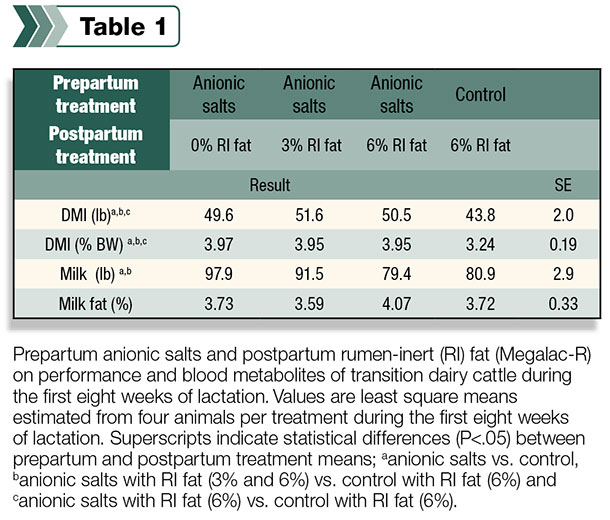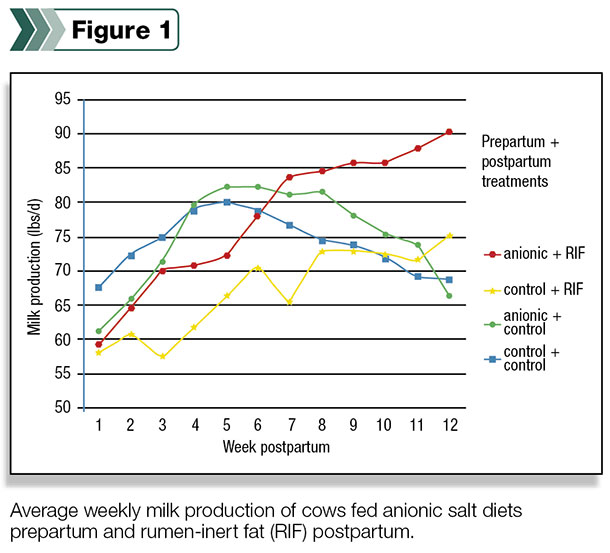The high-producing dairy cow in transition adjusts its metabolism to mobilize calcium from skeletal reserves and energy from adipose reserves in a timely fashion, along with up-regulating intake capacity, to meet nutrient requirements for peak milk production in early lactation. Circulating calcium plays an important role in physiological regulation of both intake and lipolysis.
Feeding anionic salts in close-up rations is a proven approach to stimulate the fresh cow’s ability to mobilize and maintain circulating levels of calcium.
Feeding anionic salts prepartum promotes calcium mobilization postpartum and allows the early lactation cow to utilize higher levels of supplemental dietary fat without compromising caloric intake. This strategy could potentially prove useful for improving energy balance of fresh cows, reproduction status and lactation performance.
Can negative energy balance of fresh cows be alleviated by supplementing rumen bypass fat?
Ruminal-inert (RI) sources of fat were developed with the potential application of solving problems associated with negative energy balance of early lactation dairy cows.
However, feeding supplemental RI fat is carefully restricted in fresh cows (less than 0.75 pounds per day or 2 percent of ration DM), and there are nutritionists who recommend waiting until after peak lactation before supplementing RI fat.
It appears that the fresh cow is hypersensitive to RI fat. Experimental levels of RI fat (more than 2 percent DM) compromises DM intake to the extent that caloric intake (Mcal of NEL) is reduced, negating the purpose of feeding a more energy-dense ration (Mcal per pound of NEL). This condition further aggravates negative energy balance and periparturient health.
A dissertation project was designed to determine the mechanism for the cow’s hypersensitivity to supplemental fat in early lactation. The mechanism proposed was thought to involve hormonal signals from the cow’s body fat.
Leptin, an adipose hormone, increases sensitivity to the intestinal hormone cholecystokinin, which is secreted in response to intestinal fatty acids and downregulates reticulo-omasal orifice motility causing rumen distension and depressing caloric intake. Hypothetically, fresh cows have more body condition and more circulating leptin signaling, thus contributing to their hypersensitivity to RI fat.
A Ph.D. dissertation study, using 12 high-producing multiparous Holstein cows with four cows assigned to 0, 3 or 6 percent supplemental RI fat, was conducted to better understand the mechanism responsible for fresh cows being hypersensitive to experimental levels of RI fat.
Cows were assigned to treatments to equalize the mature equivalent predicted milk production of treatment groups. All cows were hand-fed anionic salts for two to three weeks prepartum. The major aim of the study was to relate circulating leptin and other hormones and metabolites to caloric intake depression with RI fat supplementation. However, DM intake surprisingly increased 1.5 to 7 percent with feeding RI fat ( Table 1 ).

This unprecedented response could only be attributed to feeding anionic salts prepartum. So another treatment group of four cows was added to the study that was in progress.
These cows were fed 6 percent RI fat postpartum without anionic salts prepartum. Intake of the additional treatment group was reduced as much as 18 percent in early lactation, and one cow was removed due to a displaced abomasum.
A more controlled study, as part of an MS thesis, was then conducted to gain further insight for the interaction between feeding anionic salts prepartum on feeding RI fat postpartum. Twelve multiparous Holsteins were assigned to one of four treatment groups equalized based on their mature equivalent predicted milk production.
Cows were fed either a control or anionic salt diet prepartum and a control or RI fat-supplemented diet postpartum in 2 x 2 factorial designed experiment.
The anionic salt ration contained 9.3 percent Biochlor, estimated to provide -14 mEq of dietary cation anion difference (DCAD) per 100 g DM; whereas the control prepartum diet contained provided + 13.8 mEq DCAD per 100 g DM.
Postpartum TMRs contained either 0 or 5.3 percent RI fat. Postpartum rations contained either 3.5 percent or 7.6 percent total fat and 1.65 and 1.9 Mcal NEL per pound.
Postpartum rations varied in fat and energy content but similar in roughage-to-concentrate ratio (42 to 46 percent roughage from wheat silage), percent adjusted NDF (34.8 and 37.8 percent using a 67 percent discount for concentrate sources), CP (18.5 percent) and undegradable intake protein (44.3 percent of CP). Prepartum urine pH of cows fed anionic salts was 5.8 versus 7 for those fed control diets.
The results of the second study further supported the theory that improving calcium mobilization in transition cows by feeding anionic salts enhances the fresh cow’s ability to utilize greater-than-recommended levels of RI fat in early lactation. Intake of fresh cows fed RI fat was similar to that of the control group.
There was an interaction between prepartum DCAD and postpartum RI fat feeding for milk production that occurred in early lactation (P less than 0.01).
Cattle fed anionic salts prepartum and RI fat postpartum produced 28.6 percent more milk from weeks eight to 12 as compared to controls ( Figure 1 ). Dry matter intake tended to be lower in fresh cows fed RI fat postpartum without anionic salts prepartum.

Conclusion
Specialized nutrition of the transition cow has been refined substantially in the last 25 years. Careful formulation of close-up diets, especially with regard to electrolyte balance, substantially improves performance and health of high-producing cows.
Our research suggests that early lactation cows fed anionic salts can utilize higher levels of dietary RI fat in early lactation. It appears that increased circulating calcium allows for fresh cows to consume more RI fat without compromising caloric intake, thus facilitating energy balance sooner in lactation. These preliminary results support further research on early lactation performance.
These results are qualified as being preliminary as they were obtained in metabolism studies with fewer numbers of animals than used in performance studies.
Nevertheless, the results coupled with the hormonal and metabolite data (not reported here) are very intriguing and hint at a potentially economic advantageous development in transition cow feeding that could further improve milk production, energy and reproductive status as well as periparturient health. PD
This research was funded by the Southeast Milk dairy producer check-off program. References omitted due to space but are available upon request. Click here to email an editor.
PHOTO: Intake of the additional treatment group was reduced as much as 18 percent in early lactation, and one cow was removed due to a displaced abomasum. Photo courtesy of Mark Froetschel.

-
Mark Froetschel
- Professor - animal and Dairy Science
- University of Georgia
- Email Mark Froetschel




